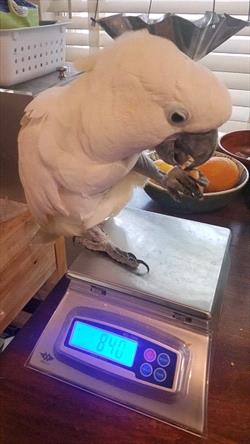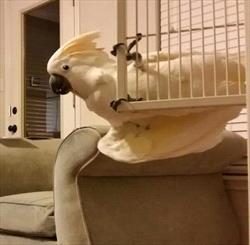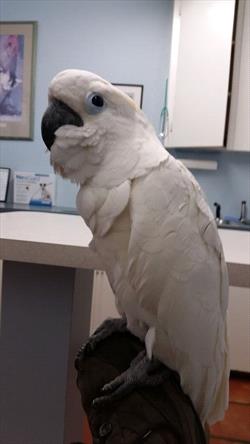How to Pick up on Potential Illness Sooner
Some people have the impression that pet birds can go from fine and healthy one day to looking seriously ill the next. While there are situations that cause a bird to get really sick really fast, oftentimes this is not the case. By the time a bird is showing more obvious signs of sickness, they have likely not been feeling well for a while. This isn’t accidental; your pet bird doesn’t want you to know they are sick. Most birds are prey species and have adapted to hide signs of sickness as looking or acting visibly sick often meant looking tasty to potential predators. What this means is that as a bird owner you have to pay closer attention to your pet in order to pick up on more subtle signs of sickness.
Observe your bird, and pay attention to:
- how your bird moves
- how it positions itself
- food intake
- drink intake
- how many droppings it makes
- what those droppings look like
- talking levels
- play and energy levels
- sleep habits
- general personality/ behavior
Nikolai

Photo Courtesy Michael Steele
You want to get to know your bird really well and establish a baseline of what normal means for that individual bird. Part of doing so means keeping track of their weight as this is a very important measure of their health. Birds have very high metabolisms and their weight can rapidly decrease with only a day or two of not eating. This rapid weight loss results in a catabolic state that can quickly be life threatening. To avoid this situation, some people weigh their birds daily with a scale, which is a more accurate way to track weight loss or gain than simply looking at them and guessing. If you do invest in a scale, make sure to weigh your bird at the same time each day as their weight may vary quite a bit throughout the day. The goal here is to establish what is normal for your bird. This is important because oftentimes when a bird starts feeling sick there will be changes away from normal but these can be easy to miss if you aren’t paying close attention.
Nikolai at play

Note the partially raised crest, bright eyes, extended wings. Photo courtesy Dr. Christy Corp-Minamiji
What Healthy Looks Like
Ideally, you should consult with your veterinarian before getting a pet bird and have done some research on what is normal and healthy for the species you plan to own. This is incredibly important to do before getting your pet bird as it will prepare you to be a better owner and can solidify whether the species you want is actually a good choice for you. Companion birds require a good amount of work and each have their own unique needs. Seriously consider whether you will consistently meet all of your bird’s needs. It’s also a good idea to know whether you believe the type of bird you want will be a good fit for you and your family before you purchase one.
As a general guideline your bird should be alert and curious about their surroundings; their feathers should be sleek, well-groomed and clean; and they should have a good appetite. A healthy bird should be symmetrical (its wings are at the same level); bear weight evenly so it is not leaning or favoring one side; perch with no problem; breathe easily with a closed mouth; and poop effortlessly. Your bird’s face, eyes, ears and nostrils should be free of any debris.
Let’s talk about your bird’s droppings. Again, normal varies by species, diet, age, and many other factors but here’s a quick description of what normal pet bird droppings should look like. There are three parts to bird droppings: feces, urates and liquid urine. Urates are semisolid material consisting of concentrated urine. Unless dealing with poultry, waterfowl or carnivorous birds, normal fresh feces should be slightly loose to firm in consistency and basically odorless. It will vary between different shades of brown when a bird is fed a pelleted diet and will be more on the greenish side if given a seed diet. The color of feces can change if a bird is fed certain foods like blackberries and sweet potatoes so it’s important to keep that in mind. Normal urates should be white and normal urine should be clear.
Earlier Signs of Sickness (Often Subtle)
One of the first signs of sickness tends to be a decrease in talking or other sounds. Other changes in behavior or personality can include increased aggression, screaming, intolerance of strangers, biting their enclosure or toys, and feather picking.
Sick Nikolai

Note the eyes -- pointing back rather than alert, the protective feathering around the beak, drooping tail and wings. Photo courtesy Michael Steele
Appearance-wise, untidy or dirty feathers may indicate a problem with the feathers or could be because the bird isn’t grooming itself; something else is going on that is making your bird not want to groom. Other early signs of disease can include flakiness on skin or beak, sores on bottoms of feet, and lameness or shifting of body weight.
Remember changes in any of the factors in the observe your bird list could indicate a problem as well. For example, if your bird’s urine isn’t clear or it isn’t eating as much as normal, these could be signs that something isn’t quite right. Looking for trends or big changes is a good idea. For example, if your bird’s weight goes down a little one day and returns to normal the next, then you probably don’t have to worry as much depending on what happens in the next few days. Before worrying, you want to see either a trend of something that isn’t good (so continual small drops in weight) or a big change. For instance, if your bird loses 10% of its bodyweight over any period of time, you need to have your bird examined by a veterinarian. In addition, there are some changes that may seem small but are not.
General and More Serious Signs of Sickness
The classic “sick bird look” is fluffed feathers, closed eyes and a more depressed, lethargic attitude. A bird only looks this way once it isn’t able to hide its sickness any longer, meaning the bird hasn’t been feeling well for a while. These birds may fluff their feathers to conserve body heat as they have lower body temperatures than normal. Alternatively, they may hold both wings away from their body and pant which indicates that they are usually heat stressed or very oxygen deprived.
Behavioral signs that should not be ignored include:
- drowsiness, increased sleepiness, partially closed eyes
- resting in a fluffed state
- decrease in activity and energy levels
- decreased appetite
- sitting low on perch
- sitting on bottom of cage
- weakness
- depression
- losing balance, falling off perch
- changes in talking or singing abilities
- scratching or picking, excessive preening
- walking in circles
Physical signs of sickness:
- foul breath
- any signs of blood
- increase or decrease in food or water intake
- changes in color or consistency of feces, urine, or urates
- reduced volume of droppings can indicate decreased food intake, decreased GI transit, or a blockage
- dry, scant droppings may indicate trouble eating, food/water shortage, or can be due to less food consumption as a result of being fed a medicated diet
- undigested food could indicate maldigestion, malabsorption, parasites or other gastrointestinal disease
- straining to defecate
- signs of respiratory involvement can include
- open mouth breathing (indicates severe issues with breathing)
- excessive chest movement
- excessive tail motion when breathing
- neck stretching
- yawning
- forward movement of head (bobbing) when taking a breath in or letting one out
- changes in body function like lameness, uneven wings, shifting weight from one leg to another
- overgrown or flaky beaks, overgrown and twisted nails
- discharge or crusts around eyes or nostrils (can indicate an eye infection and/or an upper airway infection)
- eyes dull, sunken or with abnormal color
- weight loss and/or prominent keel (breast bone)
If you notice any of these in your pet bird you should consider seeking out veterinary assistance promptly. Remember these general signs tend to happen once earlier signs of illness may have already been missed and can indicate a more serious problem. Many of these signs are general and can be caused by a number of different diseases but they all indicate that there’s a problem. The sooner you notice changes in your bird and recognize signs of early illness, the more likely you and your veterinarian will able to stop or prevent serious illness.